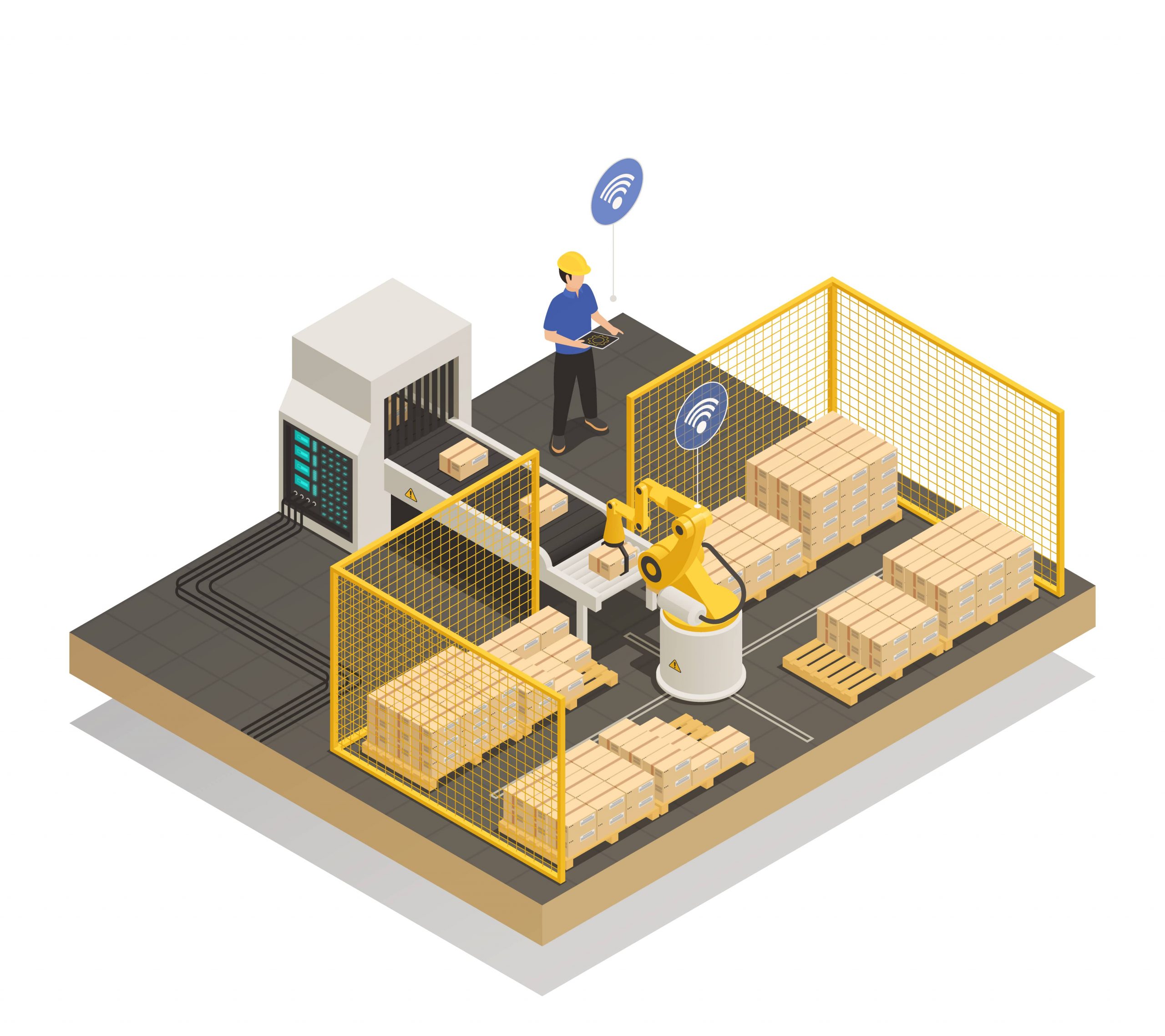Warehouses have been major components of the world supply chain over several decades and they have undergone moments significant transitions during most of these decades. The path of warehouse operations has varied evolution throughout the different phases such as manual stock-keeping, forklift usage, and so on coming up to the present smartest technologies. Advancement in automation has signaled the onset of a new epoch in this process, characterized by a massive change in the performances of such facilities.
Automation itself is the subject of this article that reveals its power, how it changes warehouse procedures and actions, their benefits and disadvantages as well as an influence on people who operate within them. In the process of exploring warehouse automation, we’ll observe how it is not just an industrial development but a vital move towards a greater technology perspective and effective operation in logistics.
What is Warehouse Automation?

The concept of automation warehouse operations involves the scientific deployment of technology and machines to warehousing activities with minimal human involvement. This modernization involves the interplay of software, hardware, and advanced technologies that improve the warehouse’s operations. It is a wide range of solutions starting from relatively simple barcode scanning or inventory management systems to highly automated and advanced robots and AI-driven machines.
Automated Guided Vehicles (AGVs): These are autonomous devices engaged in the transportation of goods within a warehouse. AGVs are navigated by guiding along predefined tracks that enhance the efficacy of material handling.
Robotic Picking Systems: These systems employ robotic arms articulating with machine vision that pick and place the items. They are a huge advantage because they help the pickers work very fast, by minimizing mistakes and allowing them to carry out their activities all through day and night. Conveyor Belts and Sortation Systems: The automation systems help in the efficient transportation of goods between stages that makes a significant contribution to throughput.
Warehouse Management Systems (WMS): Supply chain management program, or software that manages inventory levels orders supply chain fulfillment processes. All activities run seamlessly and smoothly with an efficient WMS, sometimes even dynamically.
Drones and Automated Inventory Control: So, the valuable checking of inventory has become a new trend in the world; people are increasingly using drones to prepare a serial check and reach high storage places easily and safely.
All these technologies thus play a vital role in improving the performance of the warehouse. They combine to make a harmonious setting in which these products are shipped, sorted out as products then stored and at that point dispatched with incredible velocity and precision. This has brought a devotee role to warehouse automation and nowadays it is becoming an integral component of the modern logistics and supply chain management system contributing to competitive powers all over the world.
Also Read: The Role of Test Automation in Achieving Regulatory Compliance
Benefits of Automation in Warehouse Operations
Automation integration into warehouse activities does not just create the best storage and handling system, but it is also a multitude of returns for these factors including greater operational efficiency along with accuracy.
Increased Efficiency and Speed: Industries like AGVs and robotic picker technologies work the shifts that keep factories running long after humans would call it a day, supporting 24-hour operations. This in turn results to faster order processing and overall improvement of the productivity. Automated systems will help make repetitive tasks easier, faster than human beings can do them and at the same time eliminating bottlenecks in various processes.
Enhanced Accuracy and Reduced Errors: Manual processes bring with them a high risk of error, but a move towards automation goes some way to reducing this risk. Technologies, like a barcode scanner and an automated inventory management system used that track and handle the good very accurately. (maxnovahealthcare.com) Such a precision is essential for preserving inventory integrity, eliminating waste, and improving customer satisfaction levels.
Cost Savings in the Long Term: Automation can cost much at the beginning and yet, its eventual price turnout is showing a reduction. Powered systems decrease labor related costs and considerably lower the reimbursements associated with mistakes as well as overruns. Moreover, they can enhance space management in warehouses creating opportunities to find storage alternative design.
Improved Safety: With automation, there is no manual handling of materials because automation eliminates the session of manual labor, which means employee do not encounter hazard and risk at work place. In addition, attention to detail helps not only increase the safety of workers but also lower costs and corporate upheaval caused by accidents.
Also Read: Boost Your Business With Factory Automation Solutions
Challenges and Considerations in Implementing Warehouse Automation
The challenges and aspects that were considered in implementing warehouse automation are discussed as follows.
Initial Investment Costs: To automate is, of course, expensive. The major acquisition cost of high-tech hardware such as robotic arms, an automated guided vehicle (AGV), or sophisticated computer software packages of this type are a great deal of money. This can be a huge impediment as most especially for the small and medium businesses.
Integration with Existing Systems: Adding automation, such as merged-shelf automated storage and retrieval systems with the existing warehouse procedures can come out to be very cumbersome. It involves a great deal of planning which often demands working out several dramatic changes in the organization’s current functioning. The in comparison indispensable are its fittings with existing infrastructure and also scaling over time.
Training and Skill Requirements for Staff: Humans deal with new technologies, which are implemented through automation and require special skills that trained people possess. The employees’ training should not only encompass how to operate these systems but also involve teaching them how to work along with such functioning systems. This can require a lot of time in terms of training staff and also takes plenty of finances in upskilling the employees.
Addressing Job Displacement Concerns: There may be the emergence of such automatic shift, which is likely to lead to fears of replacement and job displacement. Automation is one of the domains that can give rise to new opportunities and roles but at the same time- it also makes some jobs obsolete. In dealing with such concerns, business has to be mindful of carefully address the issues and where possible retrain employees for redeployment.
Maintaining Flexibility and Adaptability: The speed at which innovations are developed has resulted in technologies becoming obsolete rapidly, with current state-of-the-art systems likely to be out of date soon themselves. Warehouses need to keep their eyes open in anticipation or even worse, they do not replace outdated facilities with those lying ahead that work so much better.
Also Read: How Automation is Transforming Manufacturing in India
Future Trends in Warehouse Automation
These trends do not only hold the promise of improving efficiency and production value but also to change the very morphology of a warehouse environment.
AI and Machine Learning Advancements: While AI and machine learning are the advancement of automation for tomorrow, IoT has been a major development into the present time. They support smarter, dynamic systems that are capable of adapting and learning on their while still making decisions based on complex calculations for demand prediction, better management irrational or even with predictive maintenance.
Internet of Things (IoT) Integration: The IoT uses technology to link various warehouses, making the movement of information, regular ionic monitoring, and its availability systems in real-time. This seamless consolidation will be established to make warehouses reactive to make them readily interdependent, thus facilitating a better optimization of operations and logistics.
Sustainable and Green Technologies: With the current growing awareness of environmental concerns, there is a concentration on sustainability practices in warehouses. Energy-saving systems, waste-minimizing processes, and the future of renewable energy sources are among the automation technologies that will become a part of our lives.
Advanced Robotics: Although humanization and becoming smarter will become faster, the innovation in robotics would continue to make robots more agile, intelligent, and capable of performing different types of works. This involves cobots that are collaborative robots that work together with humans in sharing safety, productivity and efficacy.
These developments can hint at a future where warehouses will no longer be only storage areas but living systems that act both smart and resilient.
Boost your business performance with our automation solutions!
Final Words
Automation in warehousing tasks has been so successful as is evident by its review above. It revolutionizes a key sector of international trade, bringing unmatched efficacity, accuracy, and safety.
Although the introduction of automated systems is accompanied by several challenges, such as costly investments and well-informed labor adaptation, in terms of long-term outlooks; the lucid perspective brings to mind very powerful incentives.
To explore the full potential of automation in your warehouse operations and to stay ahead in this dynamic field, connect with Aeologic Technologies.







